Sweet Home San Francisco
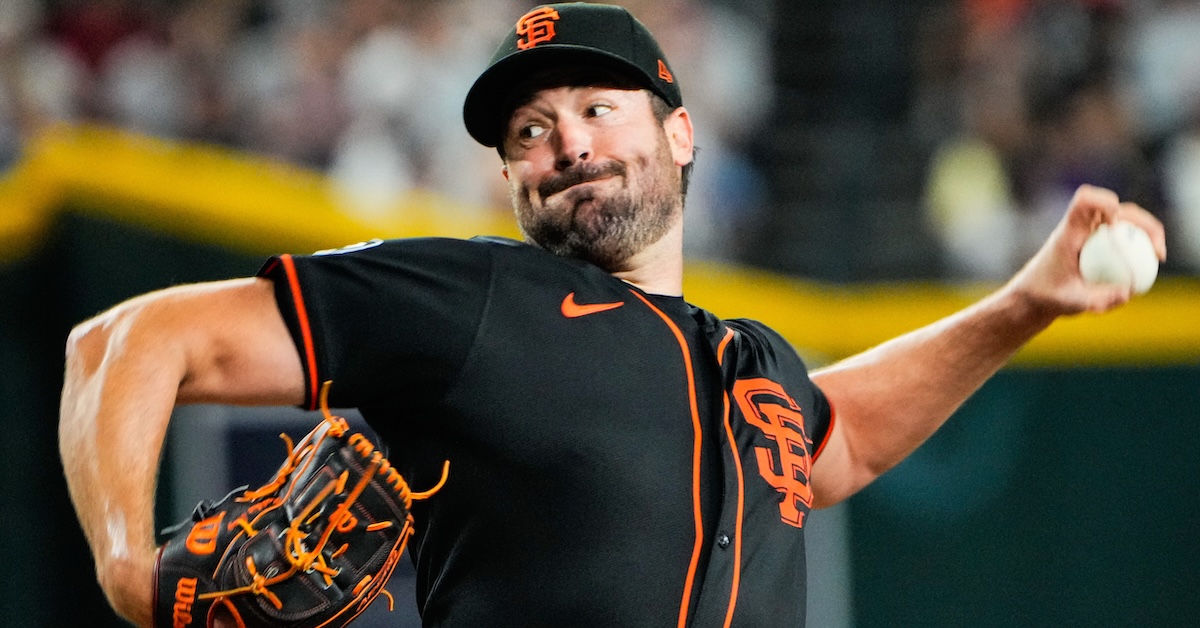
Every time I hear the name Robbie Ray, I think about the bar scene from 2002’s Sweet Home Alabama, where Reese Witherspoon’s character Melanie drunkenly stumbles up to an old friend as he’s about to attempt a pool shot. Through a fit of giggles she says, “Bobby Ray! Don’t blow this one, OK?”
Most recently, this happened when I read that Robbie Ray had been named to the National League All-Star team. Because Robbie Ray has not been blowing it this season. In fact, he’s been posting numbers not far off the pace from his 2021 Cy Young season. But despite the Cy Young on his résumé, I probably think about Bobby Ray more often than Robbie Ray, because Robbie followed up his award-winning performance with a merely average 2022, and then spent much of 2023 and 2024 on the IL. Overall, Ray’s career has been a bit of an up-and-down journey, and if we’re comparing career arcs to character arcs, Ray’s is more akin to Melanie’s than Bobby Ray’s, despite the similar name.
Dropping in on Ray’s 2021 season is roughly equivalent to where we drop in on Melanie Carmichael at the beginning of Sweet Home Alabama. Melanie (whose real last name is Smooter, but she chose to adopt a more sophisticated persona after leaving Alabama for the big city) is a fashion designer fresh off a successful debut at New York Fashion Week and newly engaged to the mayor’s son (Patrick Dempsey). Melanie has accumulated career accolades and social status, just as Ray spent his 2021 season reeling in award votes and leveling up his status as a starting pitcher.
Then, at the moment when both Ray and Carmichael seem to have it made, things begin to backslide. But before we get to that, let’s take a closer look at what led to that newfound success.
In 2021, Ray was primarily a two-pitch pitcher, throwing his four-seamer and slider a combined 90% of the time. The two-pitch mix worked, in part, because his slider generated whiffs at a 45.5% clip (19th best among all individual pitch offerings thrown at least 400 times that year), which contributed to his 32.1% strikeout rate (fourth best among all qualified pitchers). Hitters could have avoided swinging and missing by not offering at the pitch in the first place, but Ray’s fastball (both then and now) spins on a similar axis and at a similar rate as his slider, making it tricky for a hitter to guess which pitch is coming, despite the favorable 50/50 odds. Layer on Ray’s lefty, crossfire delivery from the first base side of the rubber and it becomes clear that his seemingly simple approach is deceptively complex.
Likewise, Melanie Carmichael built her success on the back of a two-pitch combo — her fastball: a successful fashion line, and her slider: a budding romance. But for as much success as both Ray and Carmichael have had, when working under a two-pronged approach, if either prong starts to weaken, things can spin out pretty quickly. For Melanie, her recent engagement has an asterisk on it because she neglected to tell her fiancé that she’s already married to her childhood sweetheart, Jake. As such, Melanie must sojourn back to Pigeon Creek, Alabama to secure a divorce. Meanwhile, Ray enters free agency following 2021 and lands in Seattle, which is not his hometown, but that’s OK because that’s not where we’re going with this metaphor anyway. In Melanie’s story, she’s recently engaged, committing to add a new relationship to her life that will have knock-on effects on all her other relationships as well. Upon arriving in Seattle, Ray commits to adding a sinker to his life, which will have knock-on effects on all his other pitches.
Just as Melanie and her fiancé Andrew (who’s poised to follow his mother into politics) made sense on paper as an up-and-coming New York power couple, it made sense on paper for Ray to add a sinker to his arsenal. And actually, Ray’s commitment to the pitch was more of a re-commitment, as he threw a sinker off and on early in his big league career. In theory, a fastball with downward movement should complement the rising action of his four-seamer and help keep right-handed hitters from sitting on the four-seam. As a southpaw, standing on the first base side of the rubber and stepping across his body even farther in that direction as he delivers the pitch, Ray makes it almost impossible for a left-handed hitter to pick up the ball out of his hand, but righties have a much better view of the pitch’s entire trajectory, creating a platoon advantage. Looking at Ray’s pitch usage over the years, it’s clear he’s always been searching for something with downward bite that he can throw on the outer half to righties without worrying about missing over the middle of the plate (which is the risk associated with throwing his slider on the outer half). In 2015 and 2016 it was the sinker, in 2017 and 2018 it was a curveball, in 2019 and 2020 it was both, in 2021 it was neither. He also dabbled with a changeup, but never threw it more than 10% of the time. Ray has been in search of a third pitch to round out his arsenal for his entire career.
In defense of Ray’s sinker, it had all the attributes a pitcher is looking for, just like Andrew had all the attributes a young woman searches for in a fiancé. I’m not sure Ray’s sinker ever had the potential to earn a nickname like McDreamy, the way Patrick Dempsey later did in Grey’s Anatomy, but McDreamy was also a brain surgeon, whereas Andrew was merely an aspiring politician. Likewise, Ray’s sinker was more aspiring politician than brain surgeon, the sort that polls well but never actually wins a meaningful election. Ray’s sinker had the drop and added arm-side run to distinguish it from his four-seamer; it looked good on a movement plot, but the results were hot garbage on a humid, New York day — the kind of thing a politician promises to take care of, but never does. The pitch yielded a wOBA over .400 in 2022. It did prevent hitters from doing quite as much damage on Ray’s four-seamer, but not enough to justify devoting 20% of his pitches to an offering with such poor outcomes.
Eventually, Melanie realizes that her perfect-on-paper fiancé isn’t the right fit for her, and that her devotion to him hurt some of her other relationships. Not only did it take time away from certain people in her life (the same way throwing a sinker severely ate into Ray’s four-seam usage), it also changed the way she carried herself in interactions with others (see the judgmental tone she brings to the oft-quoted “You’ve got a baby. In a bar,” scene).
Meanwhile, incorporating a sinker into his repertoire changed the way Robbie Ray interacted with his slider. In 2021, Ray paired four-seamers up in the zone with sliders down and in to righties (see the first image below), getting them to either chase pitches out of the zone or make weak contact on pitches in the zone. But the addition of the sinker, thrown on the outer half to right-handed batters, incentivized him to aim his slider more at the outer half as well (see the second image below). Mimicking the location and downward movement of the sinker, but without the horizontal break, should have kept hitters off-balance even further when combined with the sinker’s ability to disguise the four-seamer. However, we’ve already discussed the dangers of missing your target with a slider. As such, the pitch, though still very good overall, got knocked around a bit more (.349 slugging percentage in 2022 compared to .321 the year prior). Perhaps it would have been worth the trade-off if the sinker had performed well, but we already know how that turned out.
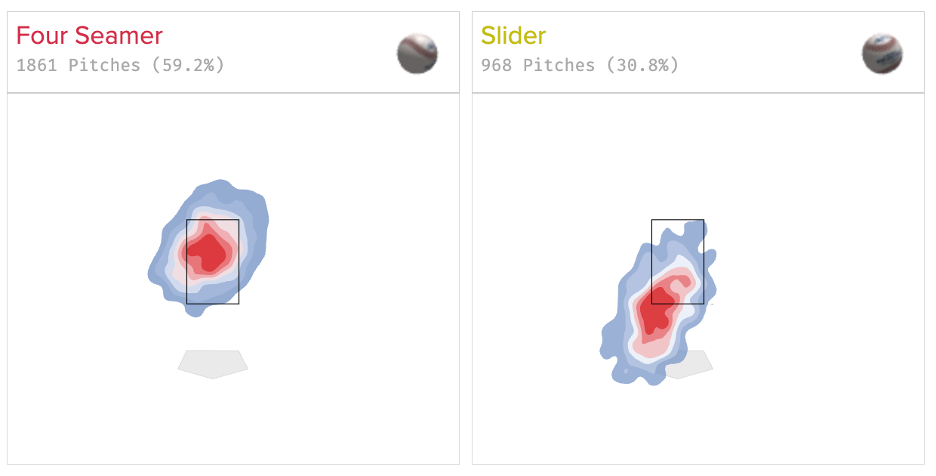
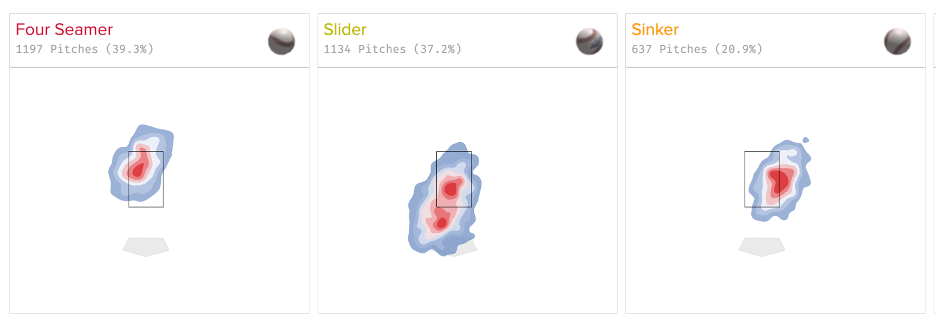
Skipping over 2023 and 2024, when Ray pitched just 34 innings total due to a smattering of injuries, that brings us to the happily ever after (at least for the time being) here in 2025; Ray is now a San Francisco Giant and thus far has pitched to an ERA- of 73 and ranks 12th overall in innings pitched. The top-line numbers for Ray this season rival those of his Cy Young year in 2021, but the shape of his success is quite different. Though the sinker is gone, Ray abandoned neither the theory, nor the hope that a pitch he’s worked on for years might suddenly break through. Instead, he’s re-working the strategy by reviving the changeup he was throwing in 2015 and 2016 along with the 2017 to 2018 edition of his knuckle curveball. He’s tinkered with both pitches over the years, leading to versions with slightly different movement profiles that never quite worked. But now he’s back to the OG versions and they’re serving him well enough that he’s using them at around a 14% clip each. So why did he abandon them in the first place?
For the same reason Melanie Smooter moved to New York and became Melanie Carmichael. She needed to define herself away from the all-consuming culture and influence of a small town. When she eventually returns to Alabama, she sees her home town with a new perspective (though it does take her a minute to shake that sense of New York superiority). She remembers, or perhaps acknowledges for the first time, that there are things to like about it. She couldn’t see it before because she felt trapped by the way the town and everyone in it was trying to define her.
Which is to say, Ray’s changeup and curveball were never really the issue, though he may have felt a certain amount of animosity toward them. Rather, he needed to head north and spend some time developing and defining the fastball and slider components of his pitching identity before he could fully appreciate what the changeup and curveball of his past could offer him in the present.
Consider Ray’s 2015 movement plot. The changeup dots are part of a messy muddle with his four-seamer and a prior attempt at a sinker. Aside from the lower velocity, there’s not much to delineate the changeup from his other offerings.
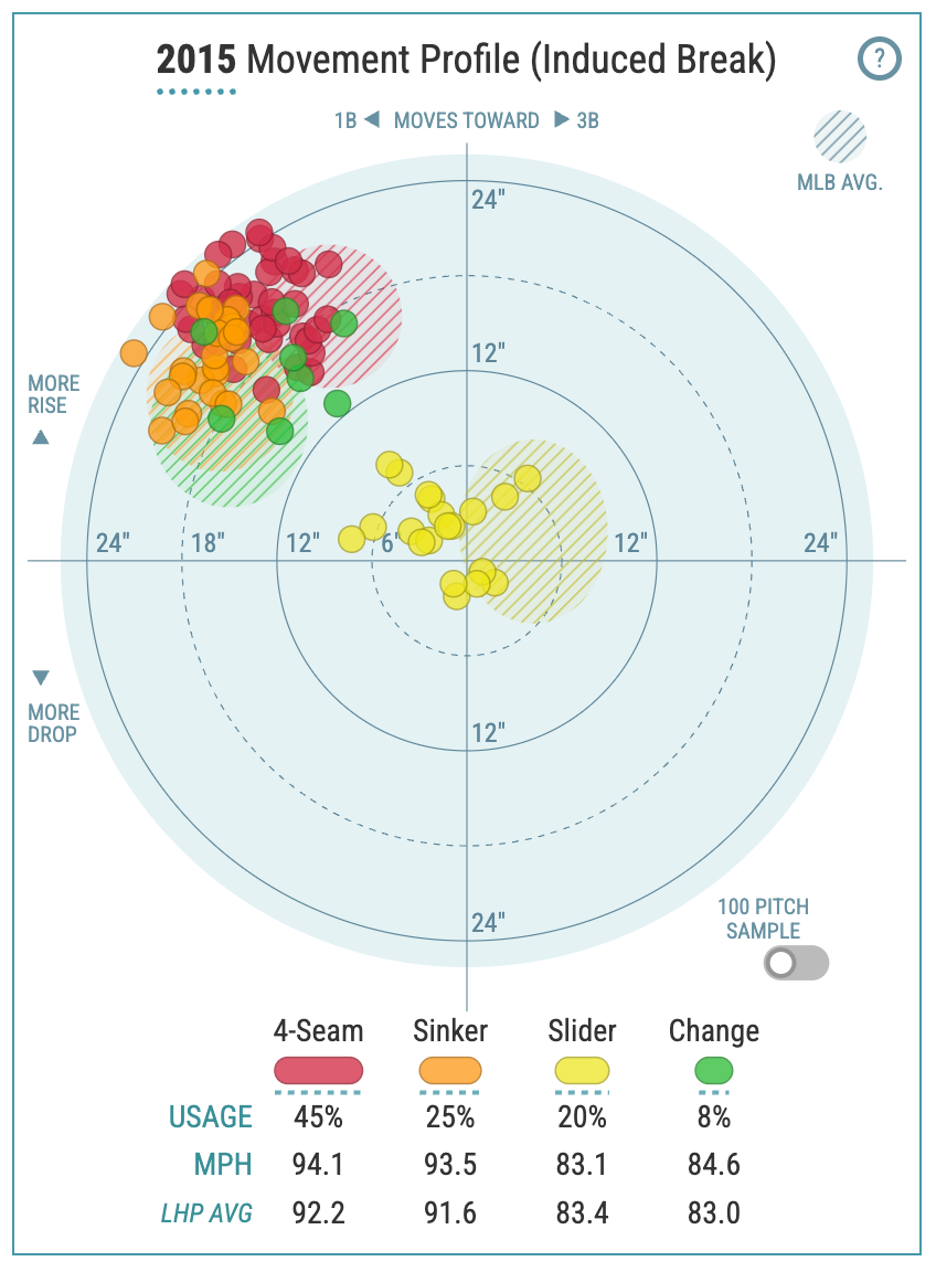
Now look at Ray’s 2018 movement plot, featuring a curveball very similar to the one he’s throwing this season. It tucks itself in right up under his slider and comes in just a couple of ticks slower, at a similar spin rate and on a mirrored spin axis. Aside from throwing them to slightly different locations, the two pitches were too similar to work as distinct offerings.
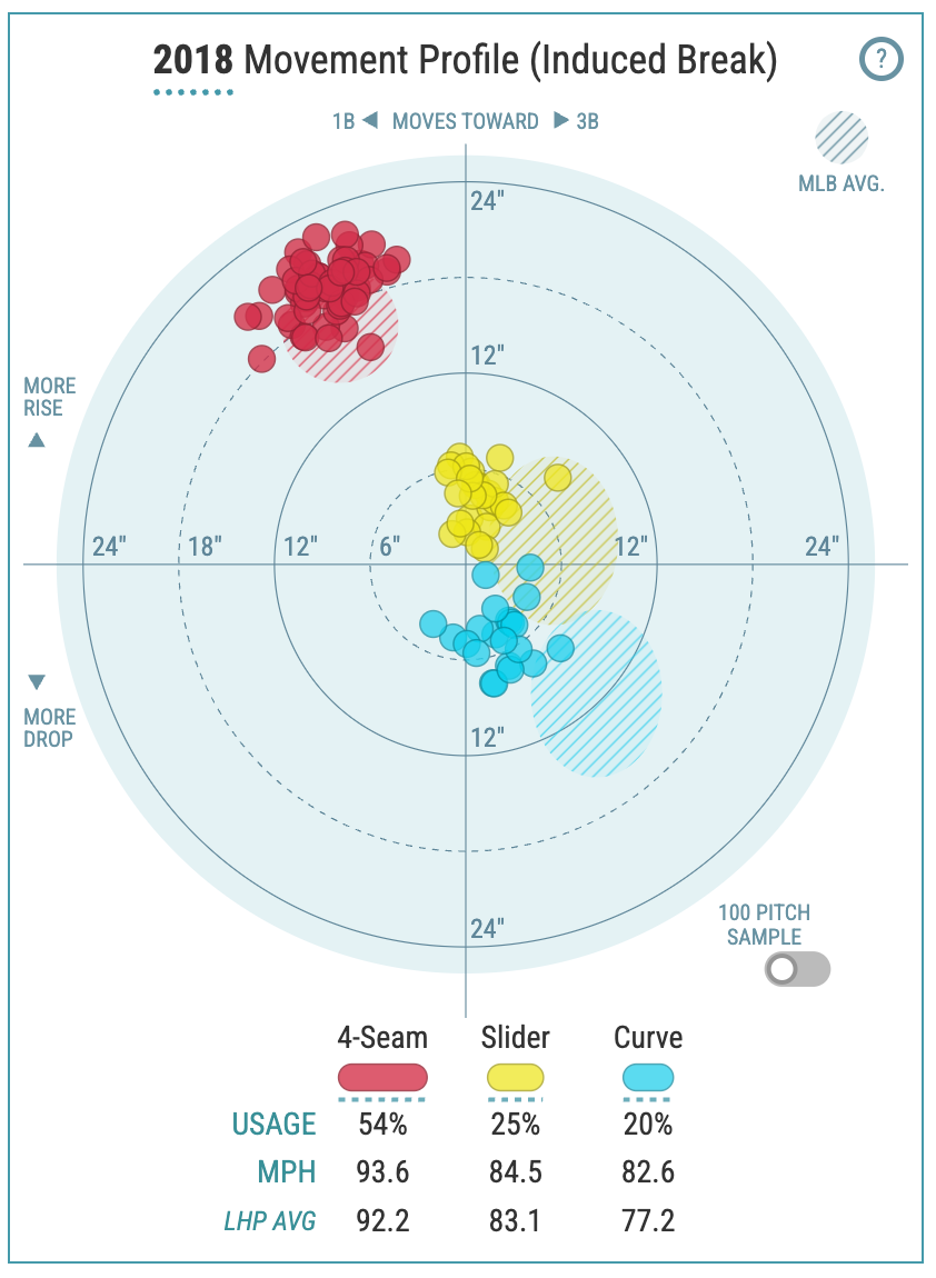
Comparing the movement plots above to this year’s edition illustrates what’s different this time around. The changeup and curveball dots haven’t really moved. Instead, Ray is getting more rise on his fastball, which in turn has translated to less drop on his slider. Evaluating those changes in a vacuum, adding rise to a four-seam fastball is generally a good thing, while a slider with less drop feels counterintuitive (but breaking balls are less formulaic, so changes in movement are harder to classify as objectively good or bad). But what’s crucial for Ray is that those changes create separation from his secondary offerings, allowing all four pitches to work better together.

Though Ray was deserving of his Cy Young in 2021, his success felt unstable due to the inherent fragility of a two-pitch mix. Particularly so because of how it left him vulnerable to right-handed hitters on days where maybe his fastball was a little more hittable or his slider wasn’t getting enough swing and miss. And that’s exactly where the changeup and curveball come in, as those pitches are tools he’s now using primarily against righties. He throws the changeup at the bottom of the zone, playing it off of his four-seamer at the top of the zone. While the knuckle curve gives him an option on the outer half of the zone so that he doesn’t have to risk hanging a slider over the heart of the plate, and instead he can go back to spamming the slider in on the feet of right-handers, where it’s more likely to induce whiffs. The difference in approach shows up in the platoon splits. In prior years against Ray, right-handed hitters have posted a wOBA 40 to 60 points higher than lefties. This year, the difference is just 26 points, the smallest gap in performance since 2017 (which is also the last time Ray’s curveball was getting decent separation from his slider).
Given that Ray is not — and never has been — a power pitcher with overwhelming stuff, instead relying on a deceptive delivery and pitches that work well as an ensemble, finding more pitches to add to his bag makes the success he’s having this year feel less like he’s squeaking by using a thinly constructed persona and more like he’s settled into his identity as a pitcher.
By the end of Sweet Home Alabama, Melanie Smooter is back, but Melanie Carmichael lives on alongside her. After all, she can’t exactly re-name her whole fashion line. But she has found a way to merge the success she found in New York with the pieces of Alabama that were always there for her and that she could never quite leave behind. Likewise, 2021 Robbie Ray is still there, relying heavily on a fastball/slider combo and pairing an extreme cross-body delivery with a north-south approach, but 2025 Robbie Ray has added some old friends to the arsenal, making for the most complete version of himself to date.
Kiri lives in the PNW while contributing part-time to FanGraphs and working full-time as a data scientist. She spent 5 years working as an analyst for multiple MLB organizations. You can find her on Bluesky @kirio.bsky.social.
Farhan was cooking